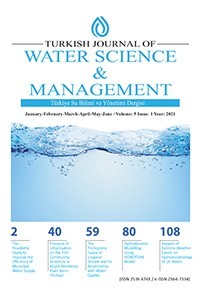Alternati̇f Reservuar Haci̇m Deği̇şi̇mleri̇ni̇n Taşkın Kontrolu Açısından Değerlendi̇rilmesi
Assessment of Flood Control Capabilities for Alternative Reservoir Storage Allocations
storage reallocation, reservoir system modeling flood frequency analysis, water supply reliability,
___
- Carter, N.C. (2010). Using Army Corps of Engineers Reservoirs for Municipal and Industrial Water Supply: Current Issues. Congressional Research Service Report for Congress. 7-5700, R41002. Washington, D.C.
- Che, D., and L.W. Mays (2015). ″Development of an Optimization/Simulation Model for Real-Time Flood-Control Operation of River-Reservoirs Systems.″ Water Resources Management, EWRA, 29:3987-4005.
- Chen, J, P. Zhong, B. Xu, and Y. Zhao (2014). ″Risk Analysis for Real-Time Flood Control Operation of a Reservoir.″ Journal of Water Resources Planning and Management, ASCE. 141(8):1-9.
- Chou, F.N., and C.W. Wu (2015). ″Stage-wise optimizing operating rules for flood control in a multi-purpose reservoir.″ Journal of Hydrology, Elsevier, 521:245-260.
- Chou, F.N., and C.W. Wu. (2013). ″Expected shortage based pre-release strategy for reservoir flood control.″ Journal of Hydrology, Elsevier, 497:1-14.
- Demirel, M. (2015). Assessment of Flood Control Capabilities for Alternative Reservoir Storage Allocations, M.S. Degree Thesis, Texas A&M University, College Station, Texas.
- Dittmann, R., F. Frochlich, R. Pohl, and M Ostrowski (2009). ″Optimum multi-objective reservoir operation with emphasis on flood control and ecology.″ Natural Hazards and Earth System Sciences, EGU, 9:1973-1980.
- Fu, X., A-. Li, and H. Wang (2014). ″Allocation of Flood Control Capacity for a Multireservoir System Located at the Yangtze River Basin.″ Water Resources Management, EWRA, 28:4823-4834.
- Hydrologic Engineering Center (2010). HEC-SSP Statistical Software Package User`s Manual. US Army Corps of Engineers, Davis, California
- Labadie, J.W. (2004). "Optimal Operation of Multireservoir Systems: State-of-the-Art Review," Journal of Water Resources Planning and Management, ASCE, 130(2):34-49.
- Liu, X., S. Guo, P. Liu, L. Chen, and X. Li (2011). ″Deriving Optimal Refill Rules for Multi-Purpose Reservoir Operation.″ Water Resources Management, Springer, 25:431-448.
- Ma, X., F. Liu, Y. Qi, L. Li, L. Jiao, X Deng, X. Wang, B. Dong, Z. Hou, Y. Zhang, and J. Wu. (2016) ″MOEA/D with biased weight adjustment inspired by user preference and its application on multi-objective reservoir flood control problem.″ Soft Computing, Sprnger, 20:4999-5023.
- McMahon, G.F., and M.C. Farmer (2004). ″Reallocation of Federal Multipurpose Reservoirs: Principles, Policy, and Practice.″ Journal of Water Resources Planning and Management, ASCE. 130(3):187-197.
- McMahon, G.F., and M.C. Farmer (2009). ″Rule-Based Storage Accounting for Multipurpose Reservoir Systems.″ Journal of Water Resources Planning and Management, ASCE. 135(4):286-297.
- Meng, X., X. Liang, B. Yan, W. Li, L. Guo, and B. Feng (2016). ″Optimizing schemes on dynamic control of resrvoir normal elevation in flood season.″ Natural Hazards. 81:1161-1175.
- Song, J.H., M.S. Kang, I Song, and S.M. Jun (2016). ″Water Balance in Irrigation Reservoirs Considering Flood Control and Irrigation Efficiency Variation.″ Journal of Irrigation and Drainage Engineering, ASCE, 142(4):1-14.
- Texas Water Development Board (2017). Water for Texas, 2017 State Water Plan. Austin Texas.
- U.S. Army Corps of Engineers (1987). Management of water control systems. Engineering Manual 1110-2-3600. Washington, D.C.
- U.S. Army Corps of Engineers (2016). ″Use of U.S. Army Corps of Engineers Reservoir Projects for Domestic, Municipal & Industrial Water Supply.″ Federal Register. Vol 81, No. 242: 91556-91590.
- U.S. Water Resources Council (1981). Guidelines for Determining Flood Flow Frequency. Bulletin 17B of the Hydrology Committee, Washington, DC.
- Wan, W., J. Zhao, J.R. Lund, T. Zhao, X. Lei, and H. Wang (2016). ″Optimal Hedging Rule for Reservoir Refill.″ Journal of Water Resources Planning and Management, ASCE, 142(11):1-13.
- Wurbs, R. A. (1996). Modeling and Analysis of Reservoir System Operations, Prentice Hall PTR, Upper Saddle River, NJ.
- Wurbs, R. A., and Hoffpauir, R. J. (2013). Water Rights Analysis Package (WRAP) Daily Modeling System. TR-430, Texas Water Resources Institute, College Station, Texas.
- Wurbs, R.A, and W.P. James (2002). Water Resources Engineering. Prentice-Hall Upper Saddle River, New Jersey.
- Wurbs, R.A. (2005). ″Texas Water Availability Modeling System.″ Journal of Water Resources Planning and Management, ASCE. 131(4):270-279.
- Wurbs, R.A. (2006). ″Water Rights Analysis Package (WRAP) Modeling System.″ in V.P. Singh & D.K. Frevert (Eds.) Watershed Models. CRC Taylor & Francis, London, 593-612.
- Wurbs, R.A. (2011). ″Chapter 1 Generalized Models of River System Development and Management.″ in: U. Uhlig (Ed.) Current Issues in Water Management, InTech Publishers, Rijeka, Croatia. 1-22.
- Wurbs, R.A. (2015a). ″Sustainable Statewide Water Management in Texas.″ Journal of Water Resources Planning and Management. ASCE. 141(12):1-10.
- Wurbs, R.A. (2015b). Water Rights Analysis Package (WRAP) Modeling System Reference Manual. TR-255. 11th Ed. Texas Water Resources Institute, College Station, Texas.
- Wurbs, R.A. (2015c). Water Rights Analysis Package (WRAP) Modeling System Users Manual. TR-256. 11th Ed. Texas Water Resources Institute, College Station, Texas.
- Wurbs, R.A. (2016). "Chapter 5 Reservoir System Management", Sustainable Water Management and Technologies, Volume I Sustainable Water Management, (D.H. Chen, Editor), Taylor & Francis/CRC Press.
- Wurbs, R.A., & Hoffpauir, R.J. (2013). Environmental Flows in Water Availability Modeling. TR-440. Texas Water Resources Institute, College Station, Texas.
- Wurbs, R.A., & Hoffpauir, R.J. (2015). Water Rights Analysis Package (WRAP) Daily Modeling System. TR-430. Texas Water Resources Institute, College Station, Texas.
- ISSN: 2536-474X
- Başlangıç: 2017
- Yayıncı: Tarım ve Orman Bakanlığı Su Yönetimi Genel Müdürlüğü
Türkiye için İklim Değişikliği Projeksiyonları: Üç Model ve İki Senaryo
Mesut DEMİRCAN, Hüdaverdi GÜRKAN, Osman ESKİOĞLU, Hüseyin ARABACI, Mustafa COŞKUN
Amerika Birleşik Devletleri’ndeki Minimum Akım Trendleri
Akarçay Havzası’nda Su Çerçeve Direktifine Göre İlk Biyolojik İzleme: Fitoplankton ve Fitobentoz
Nilsun DEMİR, Tolga ÇETİN, Caner GÖK, Müge ŞANAL
İklim Değişikliğine Adaptasyon Kapsamında Sektörel Etki Analizi Metodolojisi
Maruf Aras, Ayşegül Tanık, Ayşe Yıldırım Coşgun, Seda Abat, Mehmet Aşkıner
Kapsamlı Bir Kuraklık Yönetim Planı Oluşturulması İçin Gerekli Araçlar - Konya Havzası Çalışması
Mustafa Berk Duygu, Bilal Kirmencioğlu, Maruf Aras
Alternati̇f Reservuar Haci̇m Deği̇şi̇mleri̇ni̇n Taşkın Kontrolu Açısından Değerlendi̇rilmesi
Mustafa Demirel, Ralph A. Wurbs
